Part 2: Chapter 1, Stage 1
.jpg)
1.1
A battle rages on a nondescript battlefield in the Vektan countryside.
Enter Vektan soldiers, [Templar], and Helghast soldiers.
TEMPLAR
The comms dost worsen. Doth any person mark me?
We shall be routed without aidance. Fie!
ISA SOLDIER 1
I prithee, sir, what now?
TEMPLAR
We retire rearward.
Enter ISA Soldier, [Sanchez]
TEMPLAR
God's blood! Dost thou seek to meet thy maker?
Who's there? Stand, and unfold yourself.
SANCHEZ
For Vekta!
Private Sanchez, sir.
Quake not for the Helghast, sir;
They wade into our snare. Mines!
Lo, dead mid-step!
TEMPLAR
Will the minefield last?
SANCHEZ
Pray, not long, sir--
They've sought intrusion the greater part of the day.
TEMPLAR
Knowest thou this area, Sanchez?
SANCHEZ
Yessir! I've oppressed the Helghast since first light,
But I can no longer hearken the Forward Post o'er the ridge.
TEMPLAR
Truly. Sanchez, marshal the way.
We must hinder the Helghast's approach.
Lead us through alive.
SANCHEZ
Yessir! To the main line we shall go. Cover my advance.
[Templar and Sanchez] dodge Helghast mortars and machine gun fire. They take cover in an ISA controlled bunker outside the city.
ISA SOLDIER 2
Captain Templar, praise god! And here returns the rest of your unit.
ISA SOLDIER 3
Captain, you live and breath! Art thou injured? No.
Thitherward is the city's entrance. Thou must cross the industries to find HQ.
Helghast have broken through; they already occupy the city. Be mindful.
SANCHEZ
Godspeed, sir.
Exeunt

This first image was from the opening cutscene, but since I missed it I'll cover it here:

There's our first glimpse of the Interplanetary Strategic Alliance (ISA) logo. That's not the standard logo, though. What we see on that broken wall is the ISA "sun" logo. Which is, well, basically the same as the standard logo only it has visible sun rays radiating from it. The more commonly seen ISA logo is this one:

We talked a bit about the Helghast triad's connotations to the Nazi swastika, but now I want to look at the actual symbology of the icon itself. The number three obviously can carry a lot of meaning. Past, present, future, or mind, body, soul--there are a lot of things you can attach the number three to. Not to forget the Christian symbology of three being the Father, Son, and the Holy Ghost. Is there anything to that? Well, maybe. Look at the name of the people using the image: Helghast. The people of Helghan were originally called Helghans until Visari coined the term "Helghast". Where did the word come from? Well, "gast" is a Middle English word for "ghost". It could be that the addition of "-ghast" is meant to infer that his people now have "spirit". Either that, or he intended it to be something to menace their enemies: "hell ghost". Could it then be a perversion of "holy ghost"?
Regardless, there's more to it. Triangles are used in alchemical symbols. A triangle with the base down refers to water and earth, while a triangle with the base up refers to fire and air. The Helghast triad is shown in both forms, so if there's an alchemical connection it may be tenuous and incidental.
Lastly, the three arrows bursting outward seem to indicate expansion or explosion. The Helghast are certainly ready to fight and are eager to take Vekta for their own. This seems to be the strongest (and simplest) explanation for the use of the arrows. Conversely, the ISA use a circle for their symbol. Circles are often used to represent protective themes or shields. In opposition to the Helghast triad, the two halves of the circle could represent the ISA's purpose of containing the Helghast threat. A circle can also represent eternity (see: Ouroboros). With regards to alchemy, the circle represents spirit. This all isn't even mentioning the fact that the sun is seen as a life-giving image.
What does this all mean? Well, if we're going to set up clear good-guys and bad-guys, it helps to give them symbols that make them seem holy and life-giving, and violent and into witchcraft respectively. Although, I don't think it's that simple. Guerrilla Games is going through a lot of effort to make really clear and obvious black and white heroes and villains. I sort of brought it up in the video when crow and I talked about colour theory, but I think this is all sort of a red herring. We're supposed to think that ISA=good and Helghast=bad at first glance. Yet there's a lot more to the story than that. Everything is more of a shade of grey, and that'll become a lot more obvious as we get further into the games and start delving into the series' lore.
nine-gear crow posted:
Also, one last bit of personal analysis on the ISA logo:
This variant of the ISA logo is only seen in Killzone 1 and has been dubbed the ISA "sun" logo by players. There's no offical go-to version of it available online. I had to plumb the depths of DeviantArt to find a useable vector of it for the LP. That said, thanks to DA user FenixArtBox for the vector. (Just try to ignore all the My Little Pony artwork...).
Anyway, the sun logo is trying to colour your perception of the ISA as the unambiguous "good" guys here. Their logo is a sun, a source of light and warmth and prosperity. There are no sharp edges on the logo unlike the Helghast logo, indicating that the ISA's authority radiates outwards seemingly benevolently, as opposed to hostilely like the barbs of the Helghast logo.
Morever, the logo is green in colour, as opposed to the Helghast's black, red and white logo. The choice of colour here seemingly indicates that the ISA are on the side of "life" as all their equipment and iconography are seemingly verdant colours: green logo, green armour, warm orange highlights on their armour, and in Killzone 2 and Killzone 3, they also have soft blue lights added to their armour to contrast the harsh red and orange lights of the Helghast soldiers.
And yet, you'll notice that the ISA logo, in both versions, is a very grey, almost sickly green colour. The implication, when looking at it through a Colour Theory lens seems to indicate that, yes, there is life here, but it's slowly dying too.
This is compounded when you look at the variation between the two ISA logos between Killzone 1 and Liberation/2/3. In the first game where the ISA are allegedly the good guys, their logo is the sun variant. In the rest of the series, where the waters of the ISA's true nature and characterization becomes muddied (significantly), it's replaced with the simple sphere logo. The warmth and light has been stripped away from the ISA. They're no longer worthy of having the sun as their emblem any more, and there's a moment in Killzone 2 that demonstrates this kind in such a way I was actually struck by the symbolism of it when it happened.
....On and it also kind of looks like the OSHA High Explosive warning sign too.
SpecialK800 posted:
There are a lot of design things going on between the Helghast and ISA logos. You guys mentioned the differences in the coloring and Crow mentioned the sort of "barbed" nature of the Helghast triad. But the difference between curved lines and harsh angles is important too. Curved lines denote softer, more organic things. This is carried over with regard to the ISA. Their soldiers, though all armored, tend to have exposed heads and patches of visible skin. In Killzone 1 we see them defending a world with actual nature, though it is ravaged by war brought by the Helghast. The Helghast triad, meanwhile, uses harsh angles and straight lines, often denoting a more artificial or mechanical design. The Helghast then fight completely covered by armor and machinery. Throughout the entire series you barely ever see that sickly pale Helghast skin on a soldier. Their forces look like warfare machines from the outside. And when we finally see Helghan, well let's just say their world has a lot less nature to enjoy (at least until Killzone 3). There are so many tiny details regarding the symbols and their use, especially the variations on the Helghast triad, that you could write a book.
...
But I won't be writing it.
chiasaur11 posted:
I know it's a gimmee, but the thing that struck me about the ISA logo?
It's corporate. I mean, it looks less like a nation's flag and more like it comes at the end of an infomercial for NutriPharm.
The Helghast's symbol says "We're the baddies", but it also says "We are a nation-state with a military.". They're bad people, but they're people.
The ISA's symbol says "Cayce Pollard is about to start puking her guts out".
All this talk about religious symbology made me laugh when I screencapped this image though:
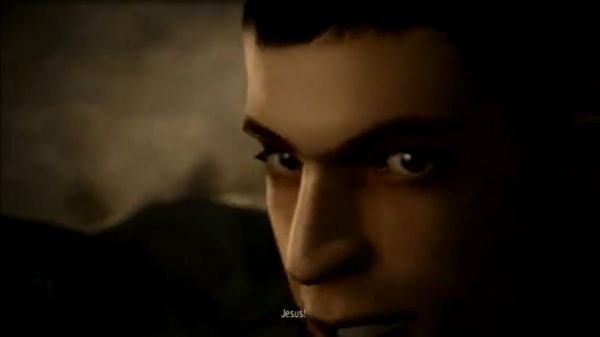
They say that there are no atheists in foxholes, and it seems for a moment that Jan Templar might have found Jesus himself--
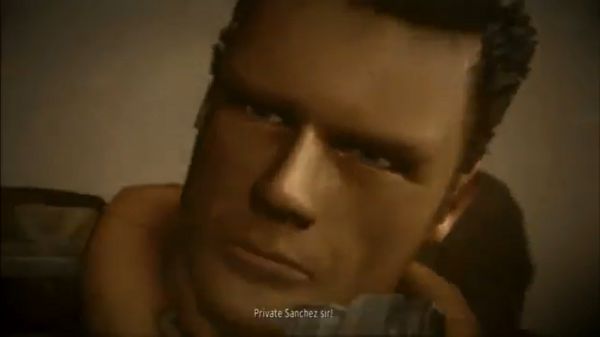
--so I think he was a bit disappointed to find out that it was only Pvt. Sanchez.

I've always thought the first few areas of Killzone were meant to serve as a "greatest hits" of WWI and WWII. After all, we're literally fighting Space Nazis, right? The game is eager to drive that point home. This first stage is one huge reference to WWI's trench warfare. I'd elaborate more, but I don't think I have to. Really, all you need to do is GIS images of WWI battlefields:

Thankfully, we have
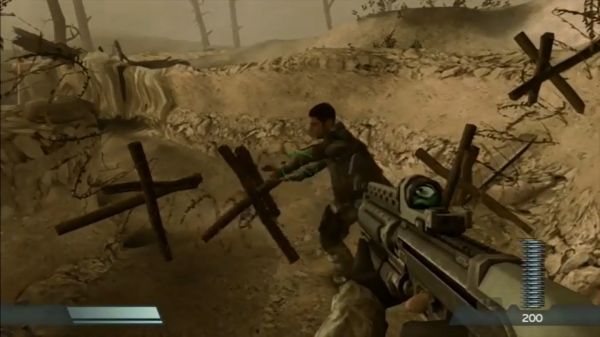
I snagged that image of the boot because I thought it was strange. I've played Killzone six or seven times now, and that's the first time I've noticed the boot. Why is it there? What does it mean? Who did it belong to? Why are there no other boots in the game? Or wait, ARE there other boots in the game!?

Crabtree posted:
To me that separated boots screams Kemmerich's Boots from All Quiet on the Western Front. A good pair of boots were one of the most precious commodities a soldier could have in the Great War, it was both comfort and protection against the horrors of Trench Foot caused by likely sitting around in dank, deteriorating trench conditions for possibly months as you wait for the next senseless charge of the day. I mean, for God's sake, this was the war where one of its deadliest battles, Verdun, spanned the course of over 9 bloody months. In the book, the boots bring nothing but death or misery to those that possess them. And yet they are still coveted and taken, from mutilated friends or robbed from corpses that obviously no longer need them. "What good are they to you, (Franz)? I can use them!"
With regards to the Hakkendorf building below, I'm not sure, but I think it's just a name. I'm not sure what its roots are or where it's from (maybe The Netherlands? That's where Guerrilla Games is based). If anyone has any thoughts, lemme know.

Wahad posted:
Hakkendorf is not a Dutch but a German name - for example, Düsseldorf, the German city, means "town/village of fools". I'm not sure what Hakken means, but if it's an alternate spelling of the word "hacken", Hakkendorf would be "town/village of chopping" - perhaps denoting a place with lots of lumber production?

Most of the historical information for Killzone doesn't appear in the games themselves. Guerrilla did write up a whole bunch of really interesting stuff, though. It used to be available on a website around the time when Killzone 2 was released, but that whole thing has since been taken down. I was fortunate enough to discover that a forum user at NeoGAF by the name of "Sentry" got screencaps of everything and made them available. Here's the thread in particular if you absolutely must read up on everything immediately. I will be covering it all with annotations over the course of the next few updates, though.
The lore splash page looked something like this:
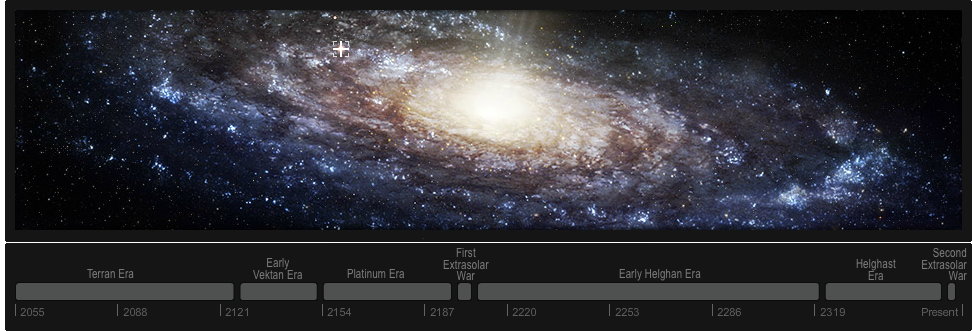
As you can see, there are seven distinct eras covering centuries of time in the not-too-distant future. Killzone, Killzone 2, Killzone 3, Killzone: Liberation, and Killzone: Mercenary all take place during the "Second Extrasolar War" era, that tiny little wedge on the far right of the timeline. Yeah. Seriously. This series has a LOT of history. As far as I can tell, Killzone: Shadow Fall takes place between 20-30 years after the end of the Second Extrasolar War--but that's neither here nor there at the moment.

The Terran Era is the closest to our current time and has a lot of issues that we currently have. Namely: energy crises and fear of global apocalypse. It's a pretty cool back story and could easily be the genesis for any number of science fiction novels, games, or films. Heck, it even starts with World War III:
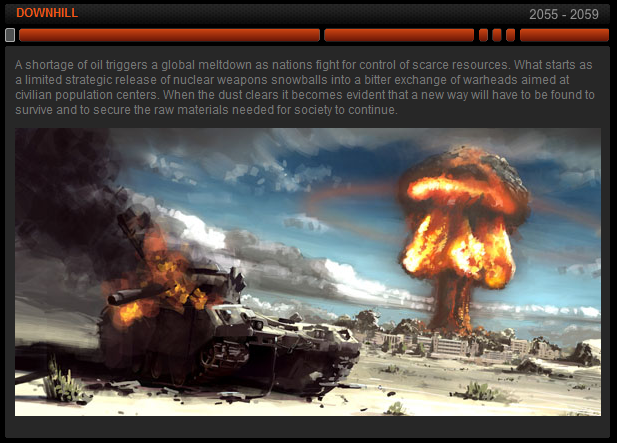
In an alternate universe, we got Mad Max. In the Killzone universe, we got space Nazis.

That's interesting. We could very well have been immediately thrust down a path where corporations are effectively ruling all space colonies a la the Alien franchise, and yet here the United Colonial Nations (UCN) are placing strict regulations in order to try and curb that potential outcome. The Helghan Corporation is present at this time, eager to become the next Weyland-Yutani.

The idea of a Space United Nations working frantically with a group of highly-trained elite volunteer soldiers from member nations to try and colonise space for a dying Earth is an awesome one. If they ever make a Killzone: Origins game, this could be an interesting concept to go off on. It could be a 4x type game. Actually, heck, they could make a 4x game in the current Killzone universe and that'd be sweet. Or it could be a Killzone: X-COM kind of thing, who knows.

Someone on staff must be a Sid Meier fan. This star stuff is a bit out of my league, so if anyone knows more about astronomy and such, please share it. As far as I can tell, Alpha Centauri is actually a binary star system: two stars orbiting each other. Hence, the Alpha Centauri A and B. Wanna take a guess at what the rocky planet around A and the lush Eden around B wind up becoming?

Nothing major to note here. A changing of the guard.
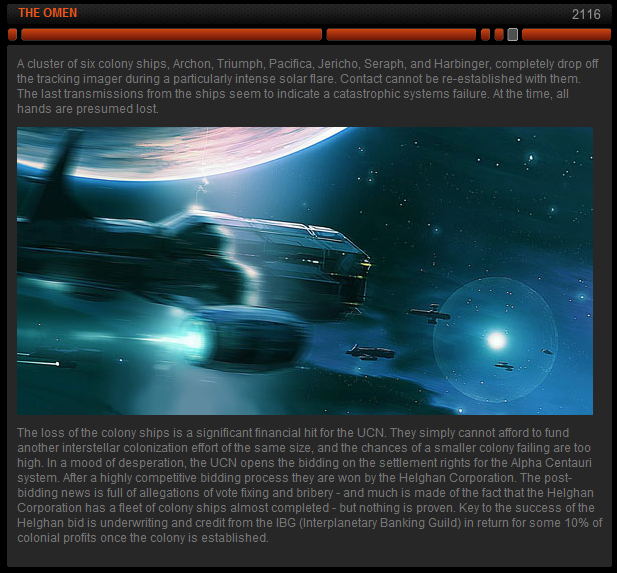
And here we get our first intonations that the Helghan Corporation might be run by less that exemplary people. A few things to note here. First, the names of the UCA Navy vessels. They're all very fitting for deep space exploration/colonisation vessels. A lot of Biblical names present.
Archon - A "ruler" or "leader". (Greek origins).
Triumph - The most obvious name. "Victory", "conquest", etc. (Old French origins)
Pacifica - Likely derived from "pacific" and not from the name of a city or company. Thus, "peaceful" or "tranquil". (Latin origins).
Jericho - An ancient city of Palestine. (Hebrew origins).
Seraph - A member of the highest order of angels. (Hebrew origins).
Harbinger - A herald marking the approach of another. (An alteration of a Middle English word. Has roots as far back as Old Saxon and Old High German).
Too bad they all
Also, I like to imagine that the Interplanetary Banking Guild (IBG) and Dune's Spacing Guild are basically the same thing.

We discover that the two planets, Helghan and Vekta, are both named for and by the Helghan Corporation and its CEO. Interesting. This ends the so-called "Terran Era". Now that space colonisation is one its way, humans are no longer limited to inhabiting the Earth.

Gameplay in all the Killzone games are a bit clunky. Part of this is to really ground the player in the game universe and feel like they're truly responsible for the actions they take on-screen. For some people, this really worked. For others, they hated it. One thing's for sure, the games have often needed tweaking to their controls to be comfortable to play for most people.
The first thing I did in the video was turn off AUTO RELOAD. It's a horrible, horrible thing that is a minor help at the best of times, and responsible for most avoidable deaths at the worst of times. Reloading in this game is a slow, ponderous task. Sure, it's more realistic, but it also means you need to adjust your play style accordingly. If you run out of bullets in a fire fight without cover, what makes more sense: pausing to reload your gun, or quickly drawing out a second loaded firearm? It's the latter. Always the latter. You can carry three guns on you at a time (that's one more than Killzone's contemporary Halo! Truly, the Halo-killer!), so there's no excuse to not use that to your advantage. With AUTO RELOAD on, though, it negates that bonus as you can't interrupt the reload action. Once it starts you just gotta let it play out and hope you don't die before it's done. So turning it off is a great idea.
The Helghast's StA-52 AR was a rather hated gun by the internet because of its second fire, a single shotgun shell. See, on paper it's a great idea: if you turn around a corner and are ambushed by a Helghast squad, you can quickly off the closest soldier with the single shotgun blast, and spray the remaining 60 rifle rounds at the others while you retreat for cover. In practice, the AUTO RELOAD made the player reload the underslung shotgun after that single shot, leaving them open to fire and wishing they could use the primary fire. Again, no auto reload, no problem.
Anyways, onto our HUD. As you probably saw, there's a Health Bar, a Stamina Bar, and an Ammo Bar showing off a gun's remaining primary and secondary rounds. I mentioned that each character plays a bit differently, and that's true. Each character regenerates Health and Stamina at different rates and takes different amounts of damage--not to mention they start with different weapons, move at different speeds, specialize in certain weapons, and have access to certain areas. It all sounds very cool, but in practice, the differences are rather minimal.
Still, here's Templar's stats:
Templar
HEALTH REGEN - Average
STAMINA REGEN - Average
DEFENSE - Average
WEAPONS - M82-G Assault Rifle, M4 Semi-Automatic Pistol
ABILITIES - Can climb ladders, and vault over obstacles

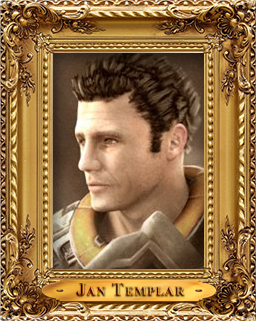
Voiced by Kal Weber
I mentioned in the video that I thought Templar was our "everyman action hero". Each of the four main characters in Killzone seem to be portraying an action hero trope, and in Templar's case, he's the blue-collar working stiff caught in a bad situation. He's John McClane, Martin Brody, Marty McFly, Duke Nukem, Theo Faron, Sarah Connor, whatever. He's the guy who's not too much unlike yourself, who deals with everyday problems not unlike yourself, and who can never seem to catch a break not unlike yourself. As we'll see, Templar is the most grounded of the group, can take John McClane-like beatings and keep on kicking, and has loveable relationship problems.
Despite being one of four playable characters, I feel like Templar is the "canon" main character, and as such I'll be playing him for the game's ending (though frankly, the ending differences between characters are so minimal it's laughable). He'll also be our protagonist in the PSP game and a major character in the sequel.
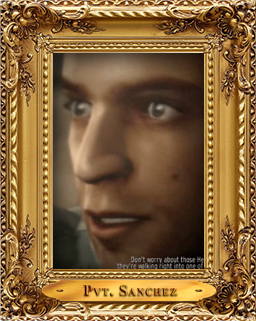
Uncredited--though there are, like, five people credited as "Additional ISA Voices"
An ISA Private who was present on the ground for the Helghast's initial invasion. Sanchez is a pretty gung-ho kind of guy, but he gets the job done and helped get Templar through the trenches safely. He's alright in my books.

Most of the vehicles appeared in the opening cutscene, but I neglected to speak about them there, so here they are--though the Overlord and Hover APC are both in this first mission.

Helghast Cruiser
The standard Helghast fleet cruiser. It's design is based off of early First Extrasolar War variants. Heck, if it ain't broke, don't fix it, right? Has a mixed armament of missiles and AA batteries. Can hold six Overlord Dropships and carries a complement of Leechpods, small craft used for space-to-space boarding parties. They are smaller than ISA Cruisers and lack their firepower, but that allows them to have a numerical superiority and to handle better in atmospheric conditions. If it's ship-to-ship combat in space, though, the ISA Cruiser generally always comes out on top. During the Vektan invasion, they were able to overwhelm the existing ISA Navy because most Cruisers had been phased out in favour of an Orbital Defense System.
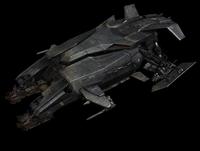
Helghast Overlord Dropship
The HGH Overlord is the backbone of the Helghast air force. Armed with twin Scylla machine guns, it is able to rain down hellish cover fire while troops rappel to the ground. Can carry eight soldiers. There is no canopy, so the pilot does not need direct line of sight to fly. Advance monitors allow them to pilot and fire, effectively making these flying tanks. As such, only sustained heavy fire can bring down these ships. Some of the most durable and reliable vessels in service, the HGH Overlords continue to be used long after the Second Extrasolar War up into the events of Killzone: Shadow Fall.
Helghast Jet Bike
A fast-attack vehicle. Lightly armoured, they can be shot down with standard assault rifles. They are rather unsafe and their Helghast Air Cavalry is prone to fatal accidents. Oh, and the pilot is uncovered, leaving them vulnerable to small rounds fire. They are basically Space Harleys, not unlike Swoops from the Star Wars EU.
Helghast Hover APC
Designed specifically for the Vektan invasion, they are far more mobile on the planet's surface than their ISA counterparts, the Lancers. Specifically, they can maneuver over muddy and rocky terrain without hindrance. They were also responsible for much of the Third Army's early victories. Despite being able to hover, they are still vulnerable to land mines. The base model can carry ten troops and is equipped with a Scylla machine gun. There is an anti-air model (shown) equipped with a Chimera Heavy Weapons Platform, though it can only hold six troops. There is also a Multiple Rocket Launcher (MRL) model, but its entire storage is used for ammunition, so it is used exclusively for fire support.

Strategic Defense Platform
Also known as the SD Platform or Orbital Defense Platform. Huge satellites with a large solar sail. They are armed with high powered lasers capable of performing pin-point bombardment strikes. They are strong enough to pierce the armour of UCN Cruisers, vessels twice the size of ISA Cruisers. Knowing this, part of the Helghast's invasion plan of Vekta was to disable and capture the SD Platforms. In doing so, they could turn them against the UCN when they inevitably showed up to reinforce Vekta. Once the SD Platforms were built, Vekta no longer saw the need for maintaining a large Navy and began demilitarizing and decommissioning their Cruisers.



M82 Assault Rifle
Manufactured by the ISA, it is their standard-issue rifle. Comes in variants with a grenade launcher or silencer attachment, known as the M82-G and M82SE respectively. Is a powerful rifle with high accuracy and an average rate of fire. It's recommended for mid-range combat, as sustained rate of fire ruins accuracy, but a trained marksman utilizing single-shots can easily deliver head shots. It's a solid rifle that you can generally keep stocked on ammunition as long as you aren't wasting shots.
We'll only see the M82-G in Killzone 1, as it's only used by ISA RRF (Rapid Reaction Force). All other games we play as regular ISA Marines, who use the standard M82. RRF soldiers are always on stand-by for an enemy invasion and make up 15% of a colony's military. Templar is RRF, just to be clear. Vektan RRF casualties were so high after the Helghast invasion that it was disbanded and its survivors absorbed into other forces.

M4 Semi-Automatic Pistol
Manufactured by the ISA. Uses .50AE ammo and has a 7-round clip. Intended to be the Space Desert Eagle and is about as useful as one, hyuk! But no, seriously, this gun is terrible and should only be used by masochists. It's awkward, clumsy, and there's a shortage of ammo for it. Ditch it as soon as possible and use any other gun.
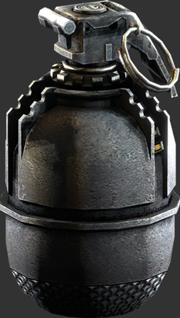
M194 Fragmentation Grenade
Manufactured by the ISA and nicknamed the "door knocker". Can kill a man within 2 metres of the explosion. Is armed with a series of lights in order to allow soldiers to more safely "cook" grenades. Very popular and also used by Helghast military--they love throwing grenades when you hide in cover too long.


StA-52 Assault Rifle
Also known as the StA-52 Light Assault Rifle. Manufactured by Stahl Arms, this gun is the workhorse of the Helghast military. Uses a helical magazine, much like many real-world bullpups. This allows for a greater ammo capacity, though the complexity of the weapon can increase malfunction (thankfully this game takes place in the future, so all those sorts of problems have been ironed out). The StA-52 AR is a solid gun for short to mid-range application. It loses accuracy with sustained fire, so isn't great for long-range combat, though its iron-sights can mitigate that problem a bit. In Killzone 1 this gun is okay at best, unless used by Hakha. This rifle is significantly more useful in later games.
Is seen in two variants: one with an underslung single-shot shotgun attachment, and one without. The only time the former is seen is in Killzone 1 in the hands of the Helghast Third Army, the invading force on Vekta under command of General Joseph Lente. Purportedly the most well-trained of the Helghast Army (watch the LP, these guys are idiots), they are certainly the most well-funded. This could explain why they were armed with more advanced hover tanks and assault rifles than Helghast in later games.

M224 MOMAG
MOMAG=Mounted Machine Gun. ISA manufactured and their most common emplaced machine gun. It's 50Cal. linkless ammunition belt allows for a higher rate of fire than other MGs, but results in massive recoil. Sustained fire is not recommended.

"Killzone" Physics:
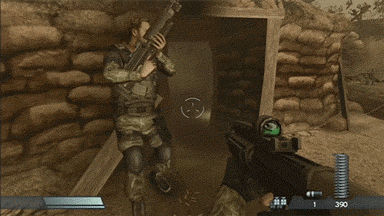
IT BEGINS.

